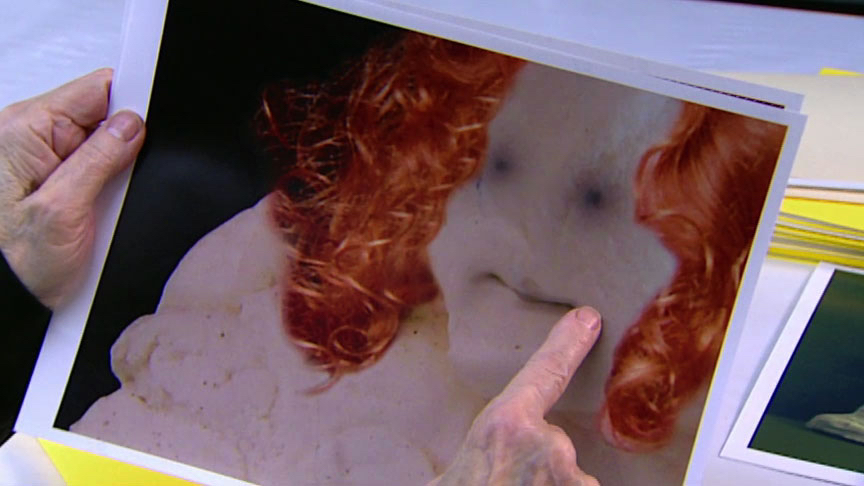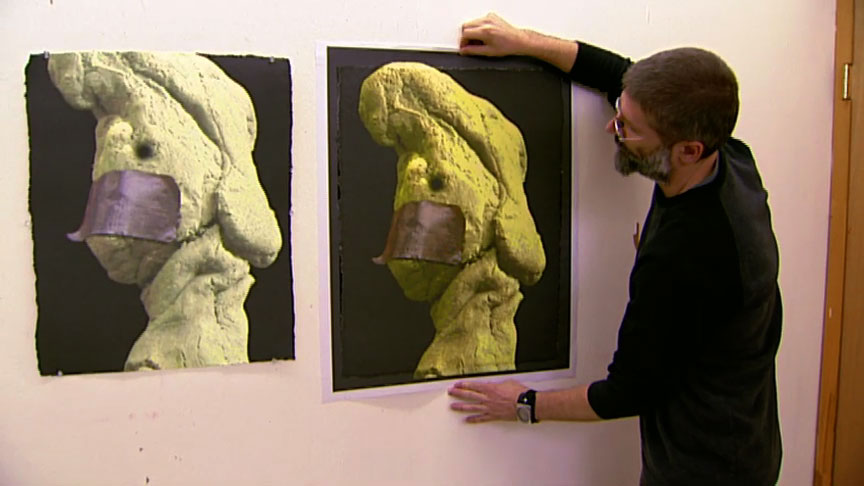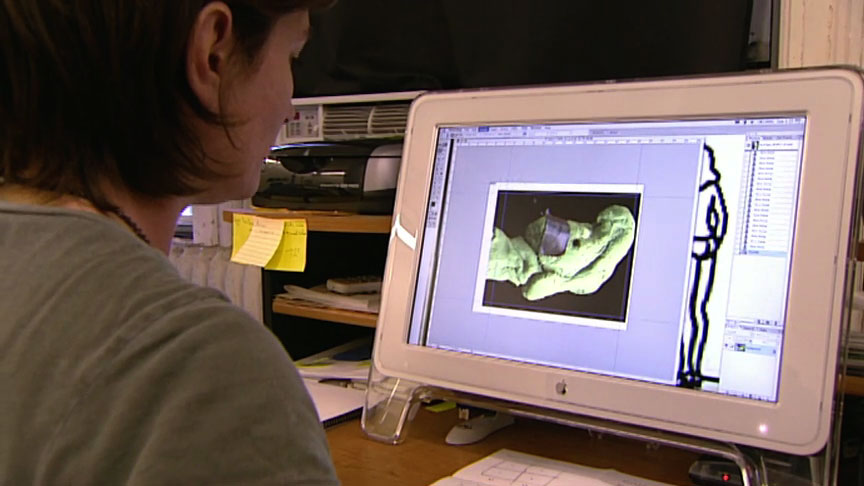Interview
Process and Technology

Production still from the Art in the Twenty-First Century Season 3 episode, Power, 2003. Segment: Ida Applebroog. © Art21, Inc. 2005.
Artist Ida Applebroog discusses her Photogenetics series—works created through a combination of photography, sculpture, painting, and digital editing.
ART21: Describe the steps of your process for these new pieces.
APPLEBROOG: The photographs actually start off making art out of children’s modeling clay. When I say art, I mean just doing some very primitive-feeling sculptures. And that’s just the beginning. It’s like making art out of art and continuing the process all the way through. For the first time, technology is at my service when I go from working with the material to the next step and the next.
These little pieces seem so ordinary and like nothing. If I place them on my stage, these little mounds of clay become monumental. You photograph them any way you like, zoom in on any part of the body, and they become something totally different. I take each one, and they’re very small. I set them up as though I’m posing them, the way a photographer would. Whatever else goes on has to do with the camera because they have to be posed in such a way that they do something, say something. They’re able to express the next few steps, and I never know what they are. The best part is that I really never know what these things are going to morph into. The good part about working with the camera is that you have no sense of what the camera’s going to give you until you see your contact sheets.
Right now, these are all proofs. I’m just working with them, and I haven’t really made any decisions as to which ones I’m going to take all the way. This one is one of those little figures. I decided to put some hair on her and give her some features. And then, of course, there’s always the change in hairstyle.

Production still from the Art in the Twenty-First Century Season 3 episode, Power, 2003. Segment: Ida Applebroog. © Art21, Inc. 2005.
ART21: Did you do that in the computer?
APPLEBROOG: You become a hairdresser, a stylist, a photographer; it doesn’t matter. The art really makes itself: art creating art with the use of technology, as I’ve never used technology before, except to turn on a light or a radio or a TV.
ART21: Do you do the photography yourself?
APPLEBROOG: [My assistant] Rita and I do the photography. And it’s wonderful because it’s this very simple kind of modeling material, but this is what happens.
I’ll start with these little sculptures. The part that is most important is that I have the single figure I will pose and place in front of the black curtain. Everything else has to happen with the camera at that point, in terms of how many ways you can pose it, whether you’re putting it at a slant, the lighting, or anything else that would make it different. By the time I got my contact sheets back, this is the one that I ended up using, but I have an awful lot to pick from.
This happens to be the face that I finally chose, putting on hair. I have my own hair; I have lots and lots of files of hair and mouths and eyes. I don’t use noses at all. I also have lots of samples of hair that I use, wigs and different things, so I can make my own hairdos. It’s not so much the color of the hair, but what I want the hair to say. Every time you change something, the significance changes, and the kind of portrait that I’m doing changes.
ART21: Where do you collect the images from?
APPLEBROOG: Fashion magazines, they give the best images of all kinds of hair and hairdos. And then, for the most part, it’s—whatever. I’ve been an image scavenger for so many years; there is no magazine that I don’t go through and pick away. The doctor’s office and the dentist’s office would be terrified of me because I’d screw up all their magazines. I’m always tearing out pages from them.
This is the one that’s been selected. This figure is actually the only male figure I have. At one time, I was making clothes for them. This is a loincloth, and I just sort of tried changing the color a bit. This is what came out and it was kind of interesting, but I didn’t really want the body.
ART21: Why didn’t you want to use the body?
APPLEBROOG: At that moment, the head was much more interesting. If I feel that something is more interesting, I’ll go for that. It’s almost like the skeletal structure of what will come about. When I start out with something at the very beginning, I can just take that and just go with it any way I like. I choose to eliminate the head or have them pose differently; that takes place and makes it an entirely different artwork.
ART21: You’ve learned how to do this kind of manipulation?
APPLEBROOG: When I first started this, I knew nothing about a computer. I didn’t know how to turn it on. So, I went to Apple, and I sat through their workshops. And during that period I met Rita McDonald, who works with me. Apple workshops gave me this much knowledge; Rita gave me this much knowledge. So, I learned an awful lot.
ART21: Have you decided to move on from the computer part alone?
APPLEBROOG: I’ve started, yes. Right now I’m trying to figure out what kind of paper to use. For many years I’ve used gampi, and I treat the gampi in such a way that it looks like skin. I could put them on traditional paper and do them a very traditional way with little borders, but I don’t think I’m going to. I have a very large printer, so I can do them large scale, and they change drastically [at] large scale. I can work them in the way I’ve always worked: fragmentations. The parts will be able to be put together and make it one piece. You know, putting pieces together, which pull together the narrative.

Production still from the Art in the Twenty-First Century Season 3 episode, Power, 2003. Segment: Ida Applebroog. © Art21, Inc. 2005.
ART21: How will the pieces be shown?
APPLEBROOG: I will be doing some editions, some small editions. But for the most part they will be single unique pieces. With the sculptures, I will be doing editions, but not in the traditional way. I’ve just started on scaling up the sculptures and using some kind of material that will be a bit more quirky than the usual expectation of what sculptures look like. And they will be quite large.
ART21: What part of the process are at you at, now?
APPLEBROOG: Someone once said this (I don’t remember who): “The nice part about making art is that it has to be either too much or not enough.” And right now, I’m not at the “not enough” stage anymore. I’m at the “too much” point, and it’s feeling very good.
ART21: What about making this work feels new?
APPLEBROOG: The only thing that’s new is the computer. I shouldn’t say that. You know the act of painting in the studio, by yourself? I remember everyone would say, “Doesn’t it get lonely being by yourself? Don’t you miss having people around?” And I’d say, “I would die if I had to have anybody in the studio while I was working.” That’s changed drastically. I used to wonder how other artists have an entire atelier of assistants and all kinds of people coming in and out. That was something that was just completely outside of anything that I could imagine. And here I am with people in my studio while I work, and I like it a lot!
ART21: Why is that?
APPLEBROOG: Well, it’s the people. If I had anybody that was obnoxious or annoying, I’d have to hang myself.

Production still from the Art in the Twenty-First Century Season 3 episode, Power, 2003. Segment: Ida Applebroog. © Art21, Inc. 2005.
ART21: But your practice remains as it was the past?
APPLEBROOG: Well, I’m using technology, if that’s any different. I don’t feel that’s different from doing painting or sculpting or drawing or anything else. It’s just another way of making art.
ART21: Who are the artists who are important to you?
APPLEBROOG: Well, it’s a range of people, from Beckett to Käthe Kollwitz to Otto Dix. There is a long, long list, including some old time actresses, which as far as I’m concerned were as influential as anyone else out there: Barbara Stanwyck, Joan Crawford, Ida Lupino. The idea of these very strong women—they were my first models of what a woman could do, so they were very important for me.
ART21: Why are they so fascinating to you?
APPLEBROOG: I would go to the movies every Sunday afternoon, sit through four features until it was night and they would drag me out. They were the women stars in those days. And what did I know? Did I say while I was sitting in the theater, “Oh, what a great model, she’s a feminist!” No, I just knew that was a really strong lady, she could really do this and this, or she could holler at that person and get away with it. It was only in later years that I put two and two together and figured out, “Yeah, they were very strong women,” and it probably served as a fantastic model.
ART21: Talk about the filmic quality of these pieces.
APPLEBROOG: They’re very cinematic. They always have been. When I’m doing these pieces, a lot of it has to do with creating my own characters, creating my own narratives. They never have a beginning, an end, a middle, but they are people. They are characters that have a life, and everyone can interpret that particular character very differently. In this way, I’ll never say, “This is supposed to be a long skinny lady who’s been unhappy.” And you know someone will look at it and say, “I can’t stand looking at that; it makes me very uncomfortable.” Well, that’s good, too.
ART21: Where do these characters come from?
APPLEBROOG: I’m just interested in narratives. Everyone has a way of remembering storytelling when they were very young and piecing it together in their own way. And I guess mine started out in terms of the actual sending out of books. Those images told a story without really saying very much. And from there, it was like a snowball that gains momentum. You have this one idea and this one concept—it’s what you do the first time. And even though it might feel like a one-liner, how much can you push it and explore it the next time?



